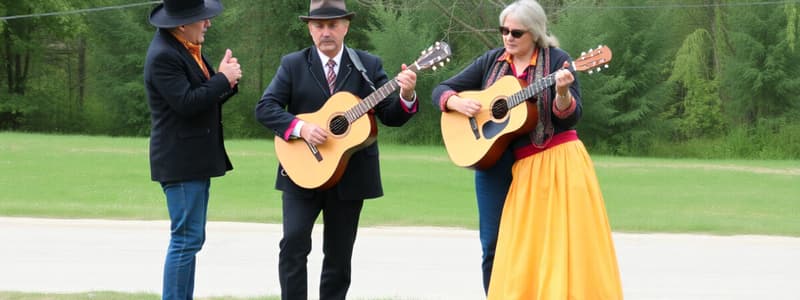Podcast
Questions and Answers
What is the primary theme of 'Si Vas Para Chile'?
What is the primary theme of 'Si Vas Para Chile'?
- A conversation about trade relations with other countries
- A guide to the best travel destinations in Chile
- A historical account of Chile's independence
- A nostalgic message from a Chilean abroad to a loved one (correct)
Which of the following best describes the style of 'Kalinka'?
Which of the following best describes the style of 'Kalinka'?
- A solemn and serious piece about historical events
- A modern pop anthem celebrating youth
- A playful and energetic folk-style song (correct)
- A classical symphony composed for orchestras
What historical context does 'My Little Town of Belz' reference?
What historical context does 'My Little Town of Belz' reference?
- The struggle of a city during the industrial revolution
- The founding of a new state in Eastern Europe
- A celebration of cultural diversity in Moldova
- The expulsion of the Jewish population during WWII (correct)
Which artist performed 'Si Vas Para Chile' in 1942?
Which artist performed 'Si Vas Para Chile' in 1942?
What nationality is associated with the song 'Kalinka'?
What nationality is associated with the song 'Kalinka'?
What emotion does 'Si Vas Para Chile' evoke in Chileans living abroad?
What emotion does 'Si Vas Para Chile' evoke in Chileans living abroad?
In which year was 'My Little Town of Belz' composed?
In which year was 'My Little Town of Belz' composed?
What is a notable modern use of the song 'Kalinka'?
What is a notable modern use of the song 'Kalinka'?
What lyrical imagery is depicted in 'Si Vas Para Chile'?
What lyrical imagery is depicted in 'Si Vas Para Chile'?
Who is credited with performing 'My Little Town of Belz'?
Who is credited with performing 'My Little Town of Belz'?
What is the primary purpose of the song 'Si Vas Para Chile'?
What is the primary purpose of the song 'Si Vas Para Chile'?
In what year was 'Kalinka' composed?
In what year was 'Kalinka' composed?
Which of the following best describes the nature of 'Kalinka'?
Which of the following best describes the nature of 'Kalinka'?
What does 'My Little Town of Belz' primarily commemorate?
What does 'My Little Town of Belz' primarily commemorate?
Which musical collaboration contributed to the widespread popularity of 'Kalinka'?
Which musical collaboration contributed to the widespread popularity of 'Kalinka'?
Who is one alleged creator of 'Si Vas Para Chile'?
Who is one alleged creator of 'Si Vas Para Chile'?
How does 'Si Vas Para Chile' reflect Chilean cultural identity?
How does 'Si Vas Para Chile' reflect Chilean cultural identity?
What genre does 'My Little Town of Belz' belong to?
What genre does 'My Little Town of Belz' belong to?
What significant event does 'My Little Town of Belz' implicitly reference?
What significant event does 'My Little Town of Belz' implicitly reference?
What element of geographical significance is highlighted in 'Si Vas Para Chile'?
What element of geographical significance is highlighted in 'Si Vas Para Chile'?
How does 'Si Vas Para Chile' influence the perception of Chilean identity among expatriates?
How does 'Si Vas Para Chile' influence the perception of Chilean identity among expatriates?
What aspect of 'Kalinka' contributes to its playful characterization despite the serious undertones of folk music?
What aspect of 'Kalinka' contributes to its playful characterization despite the serious undertones of folk music?
What do the geographical features in 'Si Vas Para Chile' symbolize for Chileans abroad?
What do the geographical features in 'Si Vas Para Chile' symbolize for Chileans abroad?
What cultural significance does 'My Little Town of Belz' hold in relation to its historical population?
What cultural significance does 'My Little Town of Belz' hold in relation to its historical population?
In what way does 'Kalinka' represent a component of Russian folklore beyond just its melody?
In what way does 'Kalinka' represent a component of Russian folklore beyond just its melody?
What purpose does 'Si Vas Para Chile' serve for Chileans who are geographically distanced from their country?
What purpose does 'Si Vas Para Chile' serve for Chileans who are geographically distanced from their country?
How does the popularity of 'Kalinka' reflect on the global perception of Russian culture?
How does the popularity of 'Kalinka' reflect on the global perception of Russian culture?
What does 'My Little Town of Belz' reveal about the cultural identity of its Jewish population?
What does 'My Little Town of Belz' reveal about the cultural identity of its Jewish population?
What role does nostalgia play in the function of 'Si Vas Para Chile' for those living outside of Chile?
What role does nostalgia play in the function of 'Si Vas Para Chile' for those living outside of Chile?
Flashcards are hidden until you start studying
Study Notes
"Si Vas Para Chile"
- Composed in 1942 by Chilean musician Chito Faró (some sources attribute it to Jorge Yáñez of Los Huasos Quincheros).
- Popular Chilean waltz, evoking nostalgia for the homeland, particularly among Chilean expatriates.
- Depicts a conversation between a Chilean abroad and a traveler visiting Chile, including descriptions of the Central Valley.
"Kalinka"
- Written in 1860 by Ivan Larionov, a Russian composer and folklorist.
- One of the most famous Russian folk songs globally; also used as a theme song in the video game Tetris.
- Playful and lighthearted, despite its operatic style.
"My Little Town of Belz" (Mein Shtetle Belz)
- Yiddish song composed in 1932 by Alexander Olshanetsky, with lyrics by Jacob Jacobs.
- Originally for the play Ghetto Song.
- References Bălți, Moldova, which once had a significant Jewish population before their expulsion to concentration camps.
- A tribute to singer Isa Kremer, who was born in Bălți and possibly its first performer.
"The Isle of Innisfree"
- Composed by Dick Farrelly (Irish songwriter, policeman, and poet).
- Haunting melody expressing longing for Ireland among Irish emigrants.
- Featured as the main theme in John Ford's film The Quiet Man (1952), despite not being credited.
- Became a worldwide hit for Bing Crosby in 1952.
Should Cultures Continue to Celebrate Dividing Songs?
- The provided songs highlight the role of music in national and cultural identity.
- These songs can foster a sense of belonging and connection to one’s heritage, but they may also exclude or alienate others.
- This raises the question of how to balance preserving cultural heritage with promoting inclusivity and understanding in an increasingly interconnected world.
"Si Vas Para Chile"
- Composed in 1942 by Chito Faró (some attribute it to Jorge Yáñez).
- Popular Chilean waltz, covered by numerous artists like Los Huasos Quincheros and Los Cuatro Cuartos.
- Depicts a conversation between a Chilean abroad and a visitor, providing directions to his loved one's home in Chile's Central Valley.
- Evokes nostalgia for Chile, particularly among its diaspora.
"Kalinka"
- Written in 1860 by Ivan Larionov.
- Well-known Russian folk song, globally recognized.
- Featured as a theme song in the video game Tetris.
- Playful and lighthearted melody despite its operatic style.
"My Little Town of Belz" (Mein Shtetle Belz)
- Written in 1932 by Jacob Jacobs (lyrics) and Alexander Olshanetsky (music).
- Yiddish song referencing Bălți, Moldova (formerly Belz), which had a large Jewish population.
- Composed for the play "Ghetto Song."
- Originally a tribute to singer Isa Kremer, a native of Bălți.
"The Isle of Innisfree"
- Composed by Dick Farrelly, an Irish songwriter, policeman, and poet.
- Haunting melody expressing the longing of Irish emigrants for their homeland.
- Featured prominently in John Ford's film "The Quiet Man" (1952), though uncredited.
- Became a worldwide hit for Bing Crosby in 1952.
"Si Vas Para Chile"
- Popular Chilean waltz composed in 1942, attributed to both Chito Faró and Jorge Yáñez.
- Depicts a conversation between a Chilean abroad and someone visiting Chile.
- Describes the Chilean countryside, evoking nostalgia for those living away from home.
- Frequently covered by various Chilean artists.
"Kalinka"
- Well-known Russian folk song written in 1860 by Ivan Larionov.
- Playful and lighthearted despite its operatic style.
- Used as a theme song for the video game Tetris.
- Features playful lyrics about a red berry.
"My Little Town of Belz"
- Yiddish song written in 1932 by Jacob Jacobs (lyrics) and Alexander Olshanetsky (music).
- Originally for the play "Ghetto Song."
- Refers to Bălți, Moldova, which once had a large Jewish population.
- Likely first performed by Isa Kremer, a singer from Bălți.
"The Isle of Innisfree"
- Haunting melody composed by Dick Farrelly, an Irish songwriter and policeman.
- Expresses longing for Ireland, appealing to emigrants.
- Featured prominently in John Ford's film The Quiet Man (though uncredited).
- Became a hit for Bing Crosby in 1952 and remains popular.
Studying That Suits You
Use AI to generate personalized quizzes and flashcards to suit your learning preferences.



